Desert Tech unveiled the MDR back in January of 2014. Development and supply chain issues finally resolved, these .308 bullpups are just now hitting online retailers and select dealer shelves near you. But should one hit your safe? We aimed to find out . . .
https://www.youtube.com/watch?v=BqwvVruY864
MDR stands for Micro Dynamic Rifle. I’m positive it’s a rifle. It’s as dynamic as you choose to make it. But is it micro? Legally speaking, yeah, it kind of is.
In the U.S., if a rifle’s barrel is shorter than 16 inches or if its overall length is shorter than 26 inches, it’s a short-barreled rifle (SBR) and subject to NFA regulation. With a 16-inch barrel and an OAL of just 26.2 inches, the MDR cuts it as close as can be.
There she is in flat coyote color, outfitted as it is from the factory with three-prong flash hider and 20-round PMAG. A reflex optic is available as an option, with a mount designed to put it on the MDR’s gas block. In the photo above, that’s the black section of Picatinny rail with the single slot.
In addition to keeping your optic toasty, mounting it to the gas block means the sight is directly affixed to the barrel. This ensures zero point of impact shift when removing and reinstalling the quickly-swapped barrel.
There’s even clearance for that factory optic inside of the MDR’s hard case, which neatly holds the broken-down rifle. But not with another optic in another location. Or a suppressor, or a bipod, or iron sights, or most handguard-mounted lights. But it does hold the MDR nicely.
Assembling the MDR is super easy. Lock the bolt to the rear, slide the barrel into place, and turn the lock bolt 180 degrees to the locked position. Then release the bolt so it locks into battery, ensuring proper headspace and consistency.
Tighten the two bolts behind the lock bolt and you’re done; you have a functional rifle. Adding the handguard is as easy as pushing a single captive pin in place, though it can be snugged down even further via two bolts.
A non-reciprocating charging handle extends from both sides of the rifle, laying down fairly flat until needed. They can be locked to the rear by lifting either side up into the steel frame’s notch. Which, yes, means you can send the bolt home with that oh-so-satisfying “HK slap.”
When the bolt locks open on empty during shooting, though, the charging handles remain forwards. After inserting a new magazine, simply hit the behind-the-mag bolt release with your thumb and the bolt goes home. This very Tavor-like lever can also be used to manually lock the bolt to the rear if, for some reason, you want to leave the charging handles forwards.
Lefties and operators can rejoice, as the MDR is truly and completely ambidextrous. The aforementioned charging handle is on both sides, plus the safety and AR-style magazine release are also mirrored exactly on left and right.
I found the magazine release extremely stiff, but it’s apparently expected to break in a bit over time. The safety selectors are small and minimalist — I would prefer a slightly larger thumb pad — but functional with a precise feel.
A third magazine-release button is located on the front of the mag well. Centrally-located, it’s also ambi. It can be depressed while grabbing a magazine to strip it out during a malfunction or for a tactical reload.
Perhaps the most ambi feature of the MDR, though, is its ejection system. First, it ejects empty cases forward.
There. With the cute little dust cover open you can envision how the cases eject nearly due forward. This allows the MDR to be shouldered on either shoulder without worry of brass to the face.
But wait! There’s more! Pop the ejection port covers off — no tools needed — and swap them around, and now the MDR ejects forward out the left side of the rifle instead.
Part of the secret is a flat-faced bolt, which lacks the typical recess into which the case head goes. This and the 12:00 extractor leaves the brass free to leave the bolt out either side. One ejection-port cover is a scissor-action lever that pushes the case into the other ejection-port cover, which is the ejection chute.
https://youtu.be/JEGoTZfCj2o
The bolt’s forward travel as it heads back into battery is what shoves the empty case out the chute. While the “lever” ejection-port cover is mandatory for the rifle’s function, the “chute” one is optional. Without it, the MDR ejects cases with authority out the side at a just-rear-of-90-degrees angle.
While the engineering here is certainly very cool, I’m not quite convinced it was necessary. At least not the side-swapping aspect, which I’d have to assume sucked up a lot of R&D time and expense and may have been responsible for some of the MDR’s go-to-market delay.
Considering the forward ejection, shooting it on the “wrong” shoulder isn’t an issue. The system could be simplified and streamlined if it ejected only out the right side. That said, when I shot it off either shoulder with it ejecting on my sternum side, empty cases did hit my support hand arm and wrist. So…lefties will appreciate it more than me.
A short-stroke gas piston drives the MDR’s action via an adjustable gas system. Simply turn an adjustment knob — the handguard has to be popped off first (again, as easy as pushing a single takedown pin) — to switch between suppressed, normal, and adverse. AKA low, medium, and high gas. I shot about 140 rounds through the MDR with the flash hider before tiring of that and switching over to suppressed-only use.
The MDR’s trigger does pull its trigger bar rather than push it, which gives it a cleaner, better feel than many other bullpup designs. However, it definitely isn’t comparable to Desert Tech’s precision bolt-action rifles. It’s longer, heavier, and spongier. Break weight is about 7.5 lbs.
Generally, I found the trigger satisfactory. It’s far from ideal for a target rifle but it’s good for a long-range battle rifle. It feels something like a mil-spec AR trigger but without any of the grit. Or like a heavier GLOCK trigger with a bit more travel. I do like the shape and feel of the just-slightly-curved trigger shoe.
Once again I slapped my lovely SIG TANGO6 5-30×56 scope on for accuracy testing and settled down at 100 yards with mixed ammo representing a variety of bullet weights and styles.
First up was Freedom Munition’s Boar Buster, which fires a 168-grain Nosler Bonded Performance soft point. This hunting round ran flawlessly in the MDR and groups hovered just under 2 MOA. The one above was typical at about 1.88 minutes.
Hornady BLACK shot, on average, tighter than the Boar Buster with the group above — thanks to that left-side outlier — being the worst of four. Average was a hair over 1.5 MOA.
Since the zero was pretty well on with the BLACK I decided to test the MDR’s POI shift with it. I removed then reinstalled the barrel and shot another five-round group, aimed at the tip of that center diamond where my knife is pointing. POI moved up over an inch and slightly to the right.
Now, I can’t say this was a totally fair test. Those barrel bolts are supposed to be torqued down to 80 inch-pounds, but the MDR ships with a simple hand tool and my Wheeler FAT Wrench maxes out at 65 inch-pounds. I did my best to be consistent, but it’s possible if not likely that some or most of that POI shift falls to inconsistent torquing.
Though the owner’s manual (I actually read it!) recommends against steel-cased ammo and Desert Tech specifically told me the MDR may not run it reliably, this gun ate through 50 rounds of Hornady Steel Match without a hitch. Not only that, but the 155-grain HPBT rounds shot groups of about 1.2 MOA.
I only had five rounds of Hotshot Elite 146 grain remaining, so sent that downrange to the tune of this 2.88 MOA group. Not exactly impressive, but apparently there’s a reason it’s the cheapest ammo here.
Finally, no accuracy test is complete without some Federal Gold Medal. I shot the heavier 175 grain to round out the testing, and it turned in two groups scratching against 1 minute but not quite there. On a calmer, non-rainy day and certainly with a lighter, crisper trigger, I’m confident the MDR would average sub-minute groups with Gold Medal.
With “battle rifle” accuracy requirements typically hovering at about 3 MOA, and bullpups having an even worse accuracy reputation than normal, the MDR’s 1-2 MOA consistency is quite good. Particularly considering it’s doing that with ballistic tips, soft points, and hollow points with varying weights and powder charges.
On the range the MDR was enjoyable to shoot. I just had to keep reminding myself that it’s a semi-auto .308 bullpup rifle, as it looks and feels like a 5.56. Well, at least until you shoot it. Though it shoots noticeably softer than a bolt-action .308 of the same weight, it’s still a .308.
You’ll want to get your weight on your front foot and ensure you have a stable, shoulders-forward stance. Basically, approach it like it’s a 5.56 machine gun and there’s no problem shooting it rapidly and keeping it on target.
However, with the MDR’s weight balance shifted rearward toward the buttstock it did exhibit more tendency toward muzzle rise than a typical AR-10, which benefits in that regard from more weight toward the muzzle. I’ll take it, though, as that rearward weight bias makes for a more maneuverable gun that can be held in position against the shoulder for a longer time without fatigue, and can even be competently handled and fired one-handed.
I was excited to shoot this thing suppressed, figuring that the mostly-sealed receiver with only its small, forward-facing ejection port truly open would be both quiet and low on gas blowback. Unfortunately, that wasn’t the case. Plenty of gaps exist between the receiver and the recoil pad, cheek rest, and ejection-port covers that gas has no problem escaping at velocity.
And I got dirty. Shooting suppressed on two different range trips, I came home looking like a chimney sweep. The first time I was wearing a dark grey shirt and didn’t notice if it was dirty, but my face was smudged up but good. The second time is seen above, with a huge mess of carbon fouling all over my right shoulder, on my neck, on my jaw, and from the corner of my mouth to my chin.
In the slow-mo at the beginning of the video up top, you can clearly see jets of gas blowing my hair around. While I didn’t actually feel gas hitting my face, I had to work hard to breathe fresh air and keep my eyes from going all fresh-cut onions.
At the end of all that, field stripping the MDR is very simple. Pop two captive takedown pins and the steel upper chassis swings up above the polymer lower. The bolt carrier with its recoil spring then slides right out the back. That’s effectively field stripped, but considering it takes about 20 seconds to remove the barrel I suppose that may as well come off for cleaning as well.
Furthermore, this quick-change barrel system allows for another MDR trick: Caliber swaps. The rifle will be available from the factory in both .308 and 5.56 (.223 Wylde, actually), then conversion kits will be available in .308, 5.56, and 300 Blackout (5.56 ETA around Thanksgiving, 300 BLK ETA is Q1 2018). For the AR-15 calibers, a magazine well insert is installed so standard AR-15 magazines can be used. Otherwise it’s as easy as swapping the barrel and bolt head.
Located in West Valley City, Utah, Desert Tech also manufactures the SRS-A2 bolt-action precision rifle, used by military and law-enforcement snipers, big-game hunters and precision-rifle competitors around the world.
On balance, I like this rifle. It ran flawlessly and feels stout and well-built. The MDR is a well thought-out, nicely-engineered firearm that meets all of its objectives. It’s a full foot shorter than an FN SCAR 17S and, while still far from inexpensive, its MSRP is a whopping $825 less. The ambidextrous crowd is certain to appreciate the MDR’s efforts there, and I really love how easy it is to break down.
Then again, I don’t actually think it’s as refined as a IWI Tavor X95. The magazine release is too stiff, the trigger isn’t as good, the balance and overall ergos aren’t quite as good, and it’s even gassier when suppressed (especially compared to the 300 BLK X95 with its adjustable gas block, which was effectively gas-free). But, yes, the MDR is chambered in a full-power rifle cartridge and the Tavor isn’t.
Specifications: Desert Tech MDR (.308)
Caliber: .308 / 7.62×51
Capacity: 20 rounds
Barrel Length: 16″
Twist Rate: 1:10″
Overall Length: 26.2″
Weight: 8.67 lbs
Colors: Black or FDE
Caliber Conversions: .223 Wylde and 300 AAC Blackout
MSRP Rifle: $2,524 ($2,274 in .223 Wylde) — available via EuroOptic and select dealers
MSRP Caliber Conversions: .223: $749 • 300 BLK: $829 • .308: $999
Ratings (out of five stars):
Reliability * * * * *
The MDR ran everything I threw at it, suppressed or not, including steel-cased ammo.
Accuracy * * * *
1-2 MOA from a semi-automatic bullpup battle rifle is significantly better than average.
Ergonomics * * * *
The mag release was too stiff and the safety levers a bit small. Otherwise the MDR puts all the controls in all the right places on both sides of the gun. Plus, it ejects to either side but can be fired just fine without making that easy swap. The rearwards balance makes it an easy rifle to wield and maneuver.
On The Range * * *
It’s a fun and enjoyable gun to shoot, but not suppressed. The MDR was louder than I had hoped and it was gassy as hell. I wish the gas block had more adjustment, as that may have helped. There’s no mistaking it for a .223 as some have claimed, but it’s very comfortable and controllable for a .308.
Overall * * * *
Desert Tech’s MDR could be refined further, but as it stands today it’s reliable, it has fully-ambidextrous controls, and it serves as a well-engineered, accurate battle rifle that packs .308 power into such a compact package it’s barely legal. The MDR is a formidable weapon.

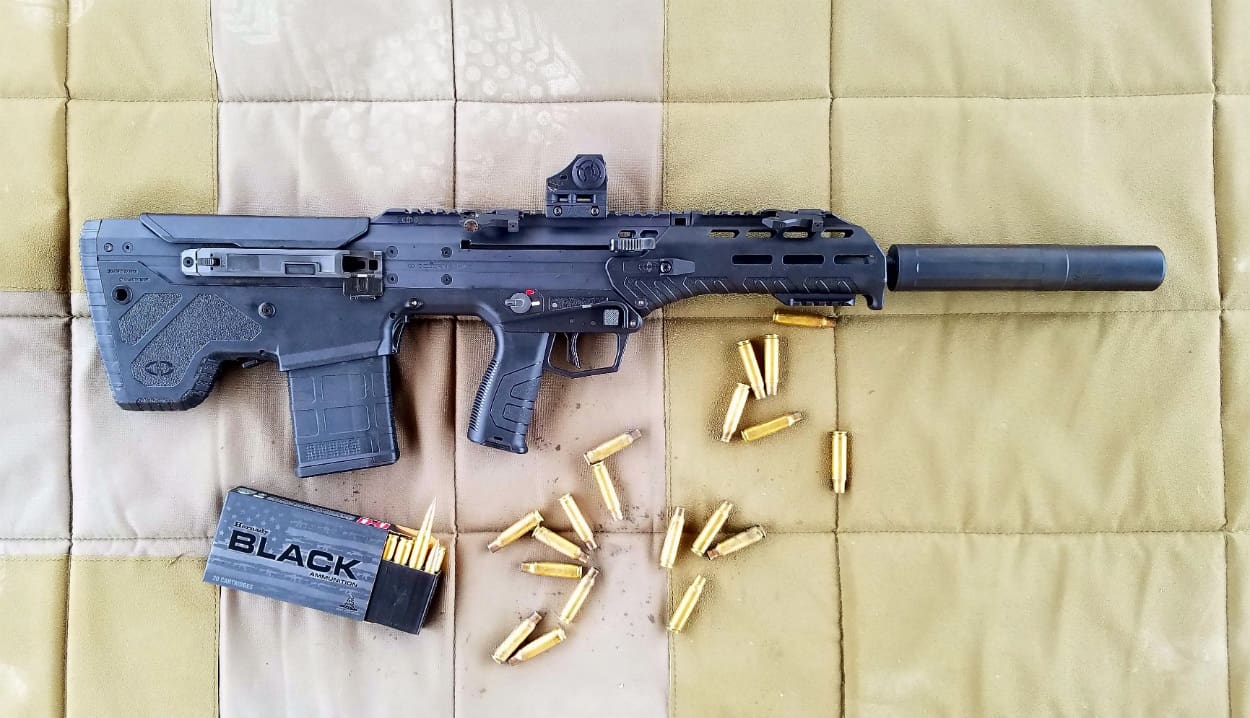
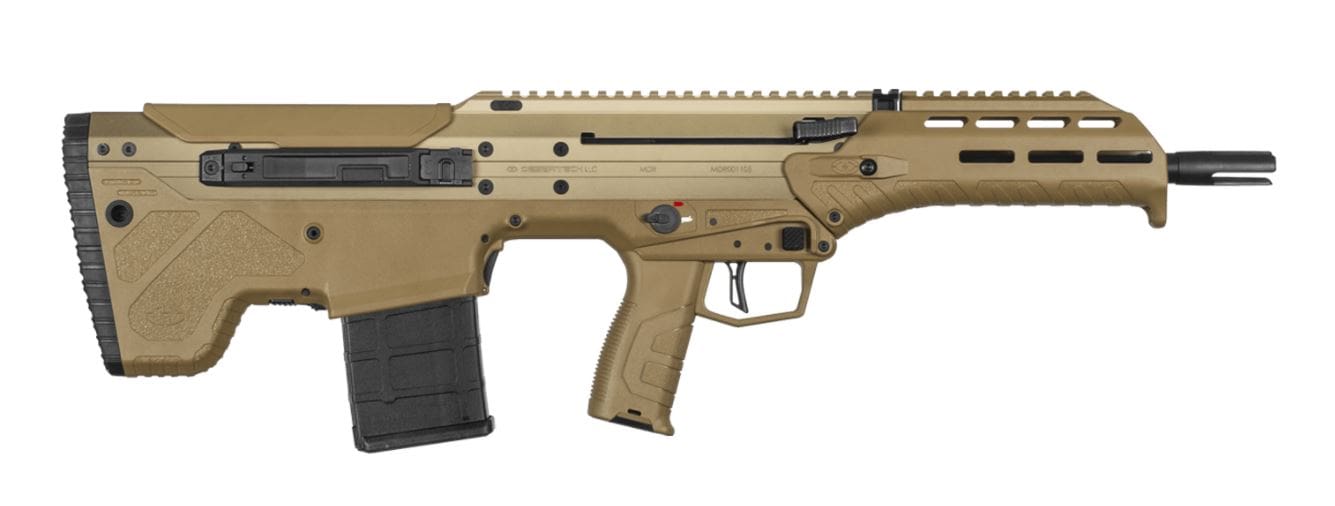
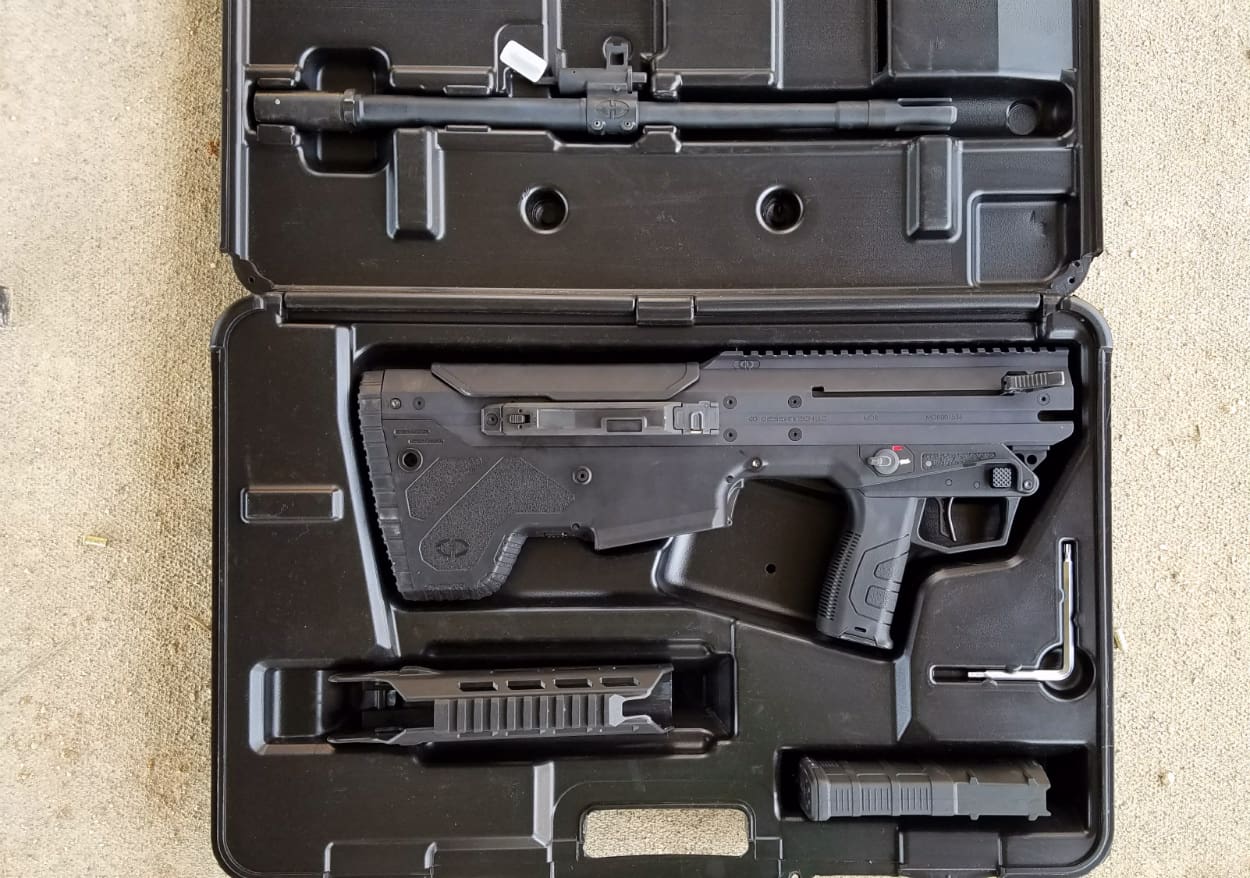
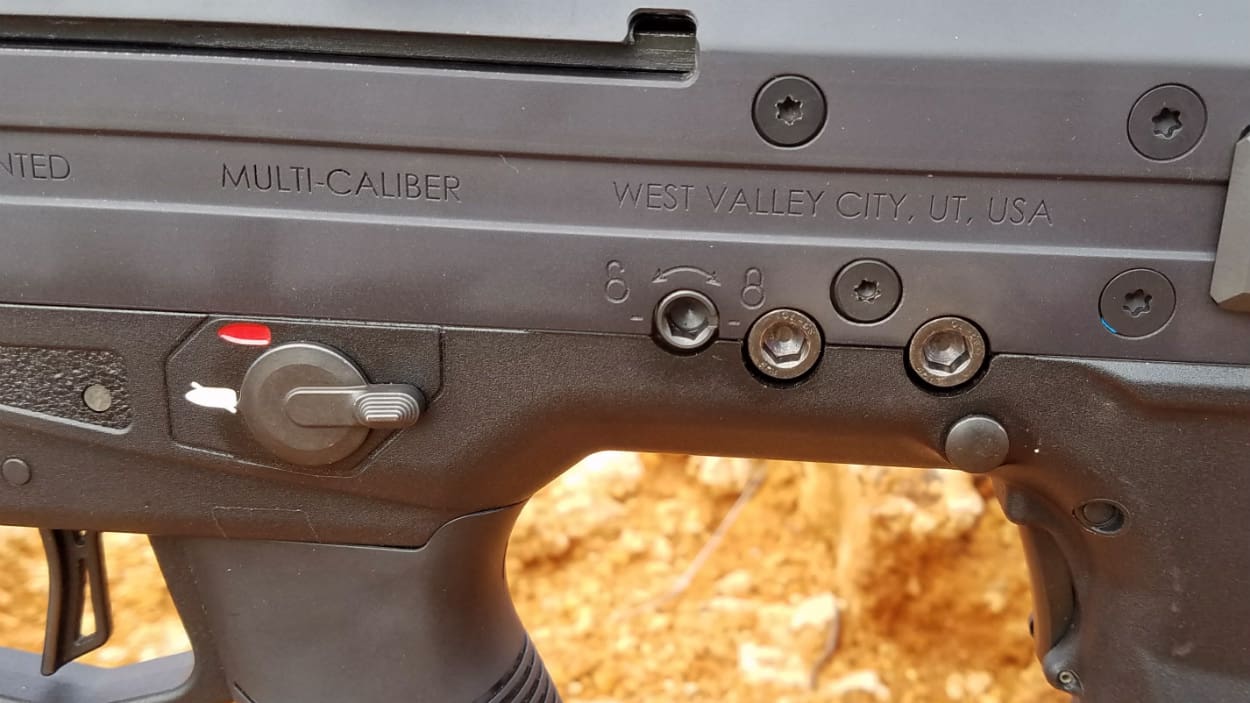
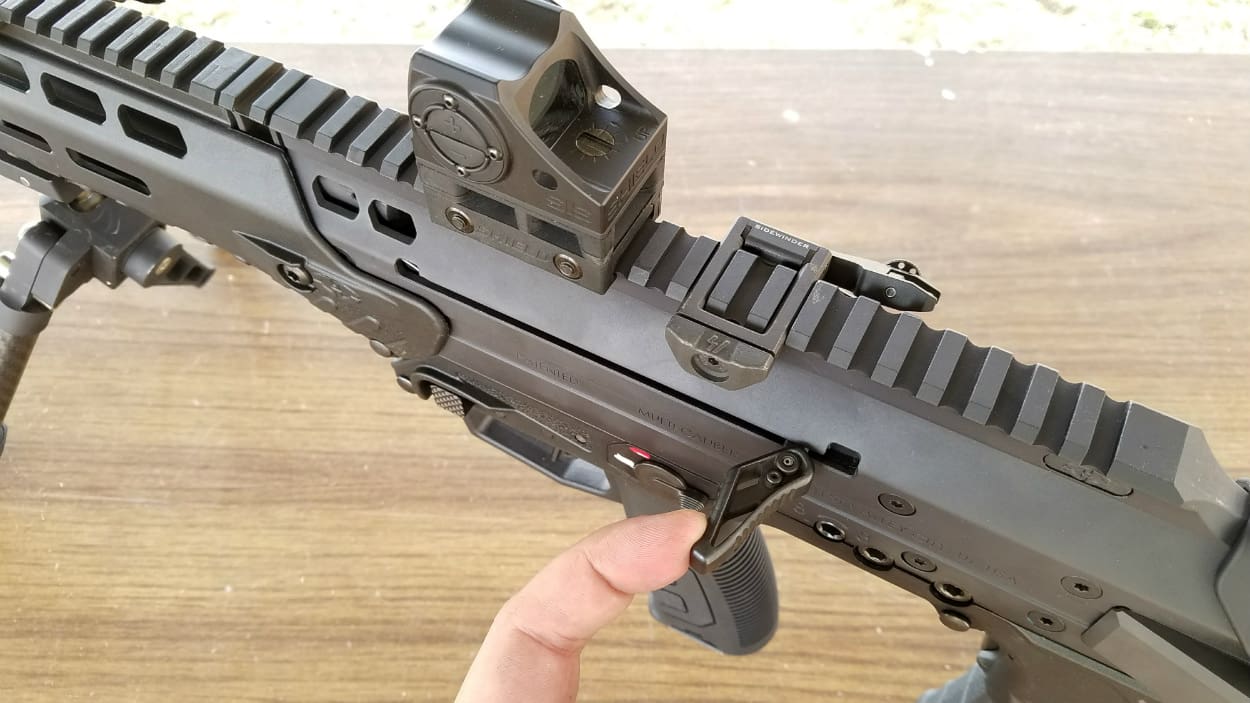
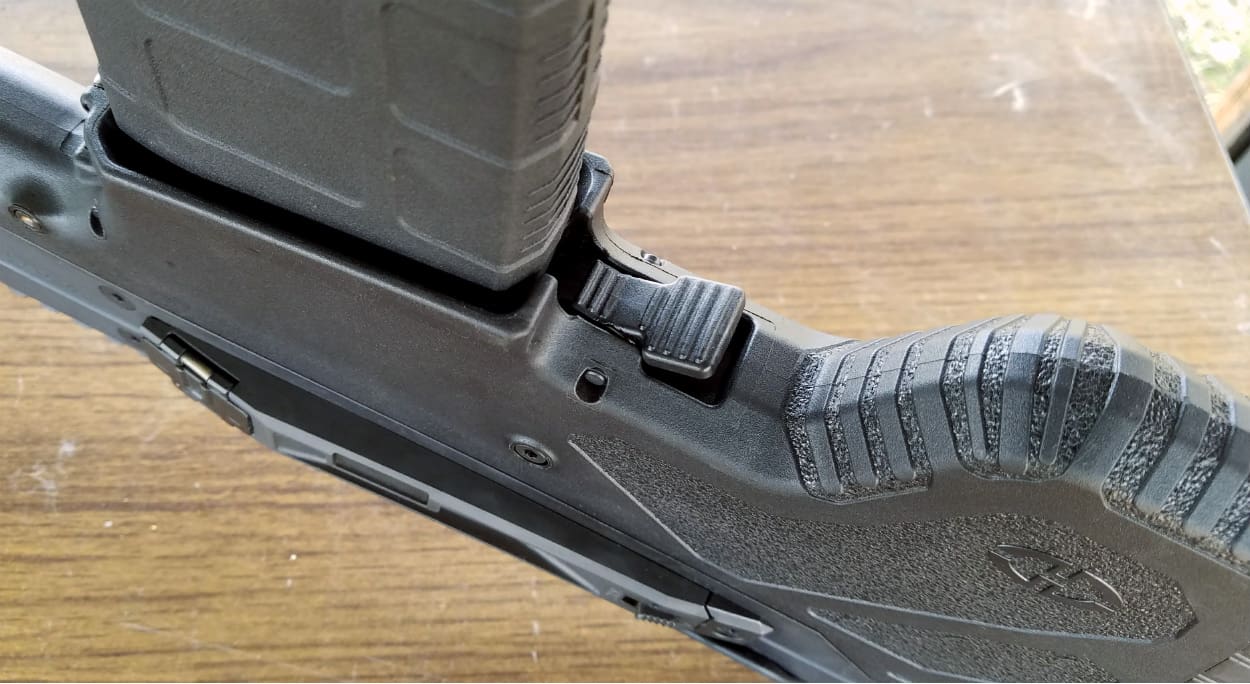
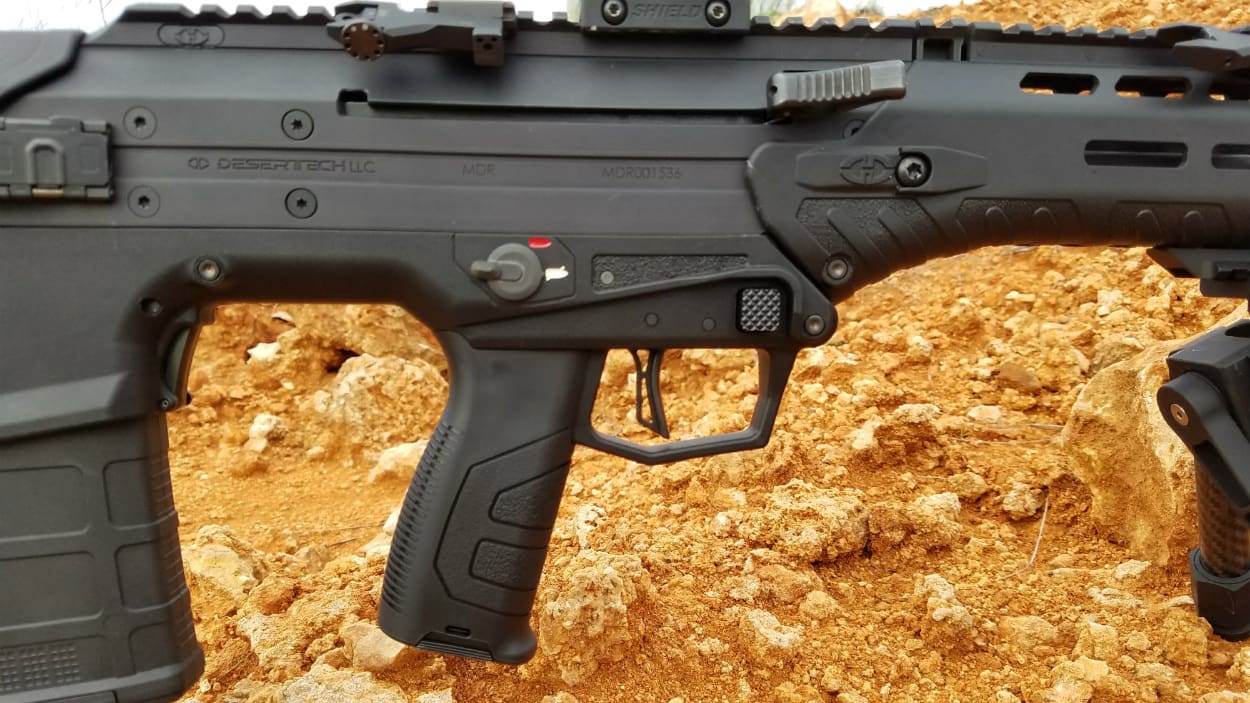
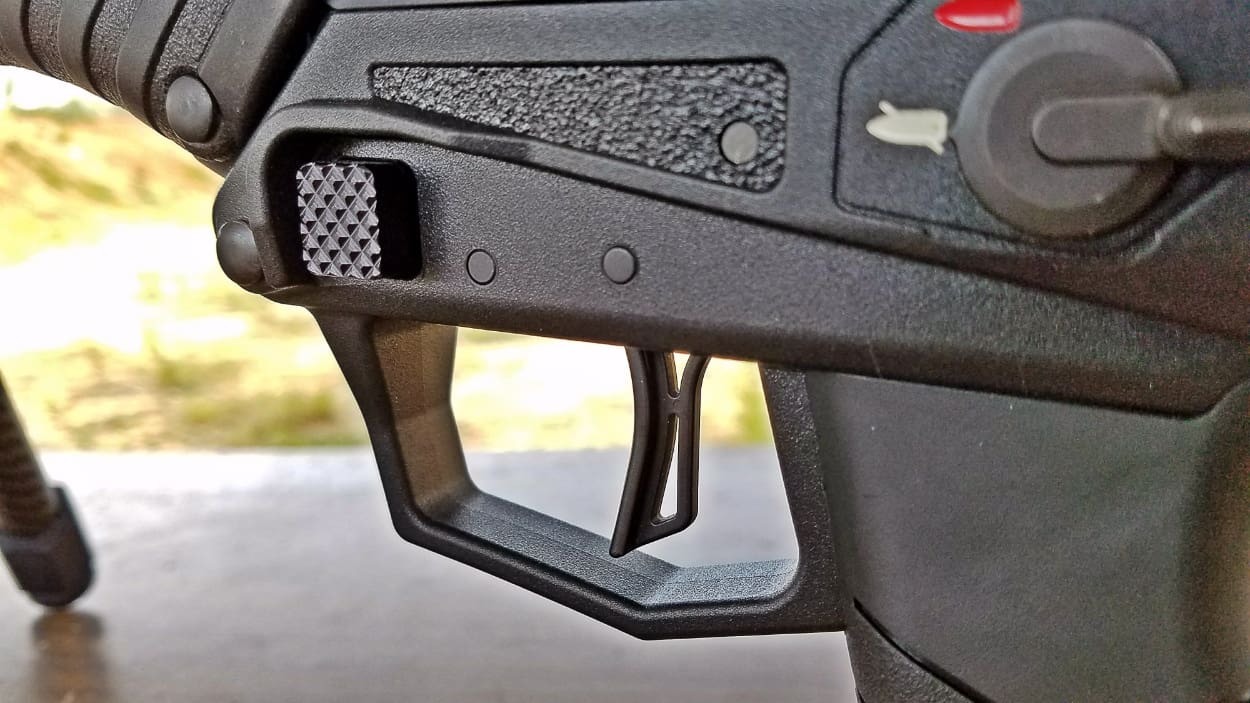
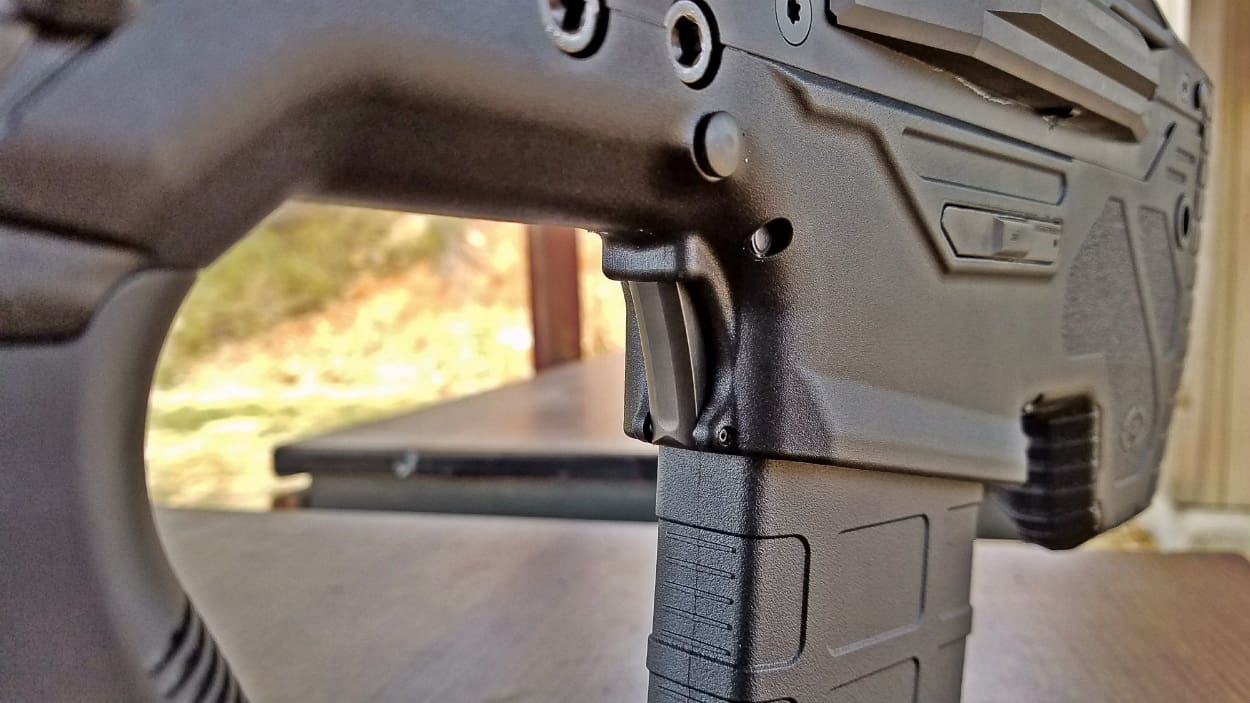

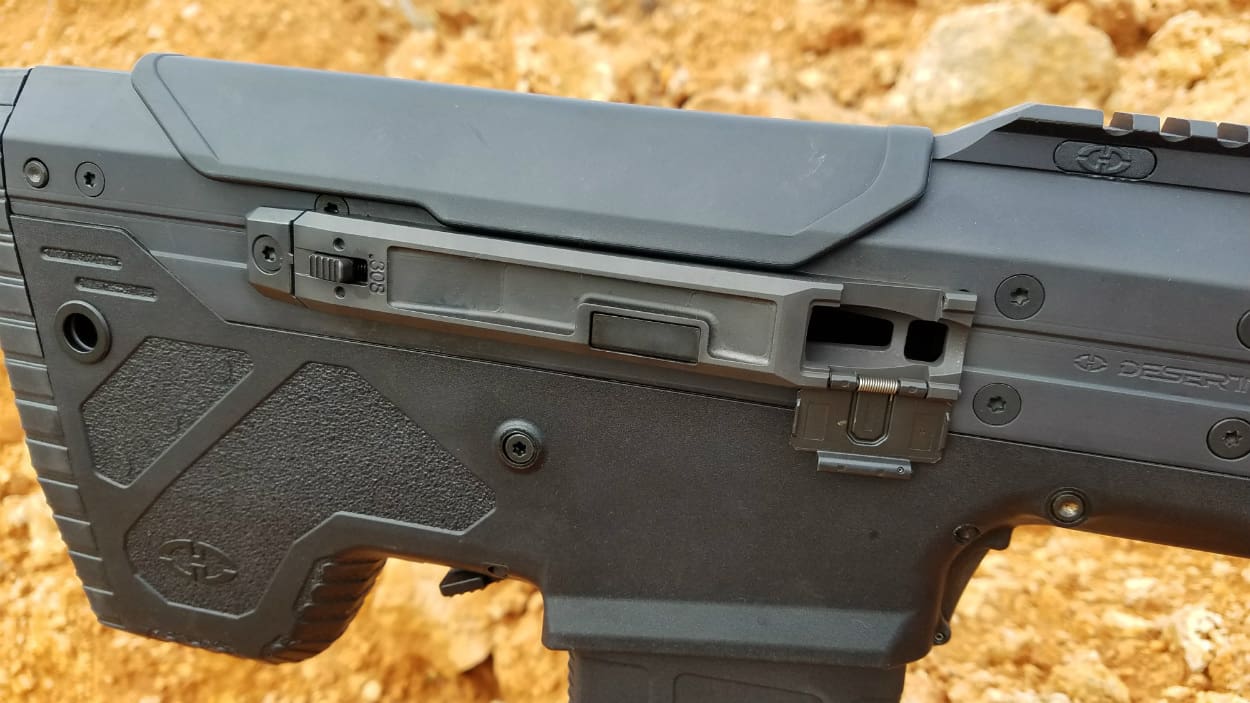
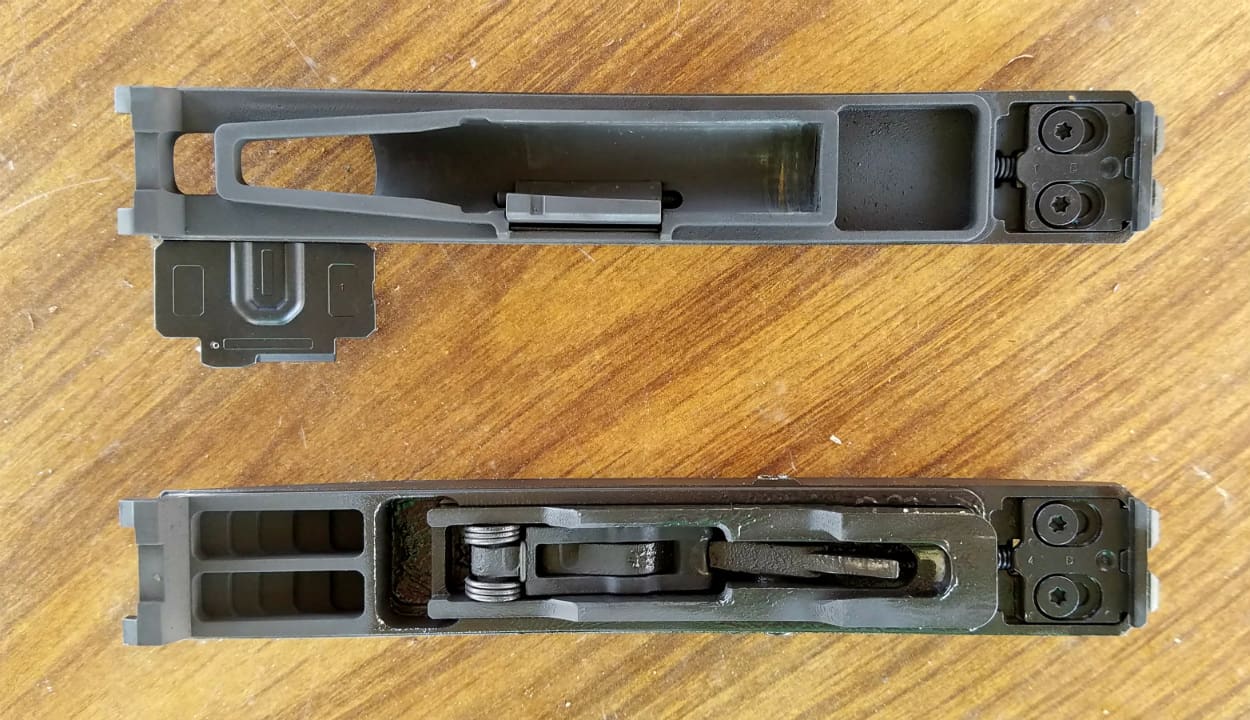
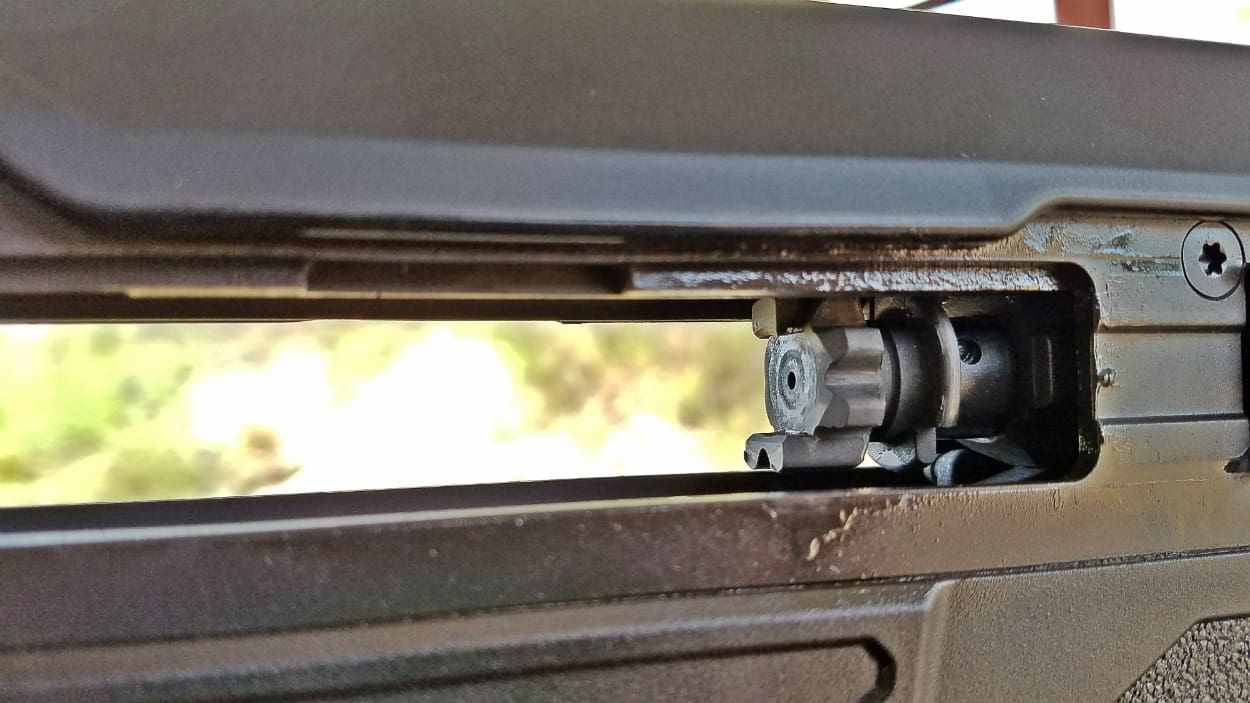


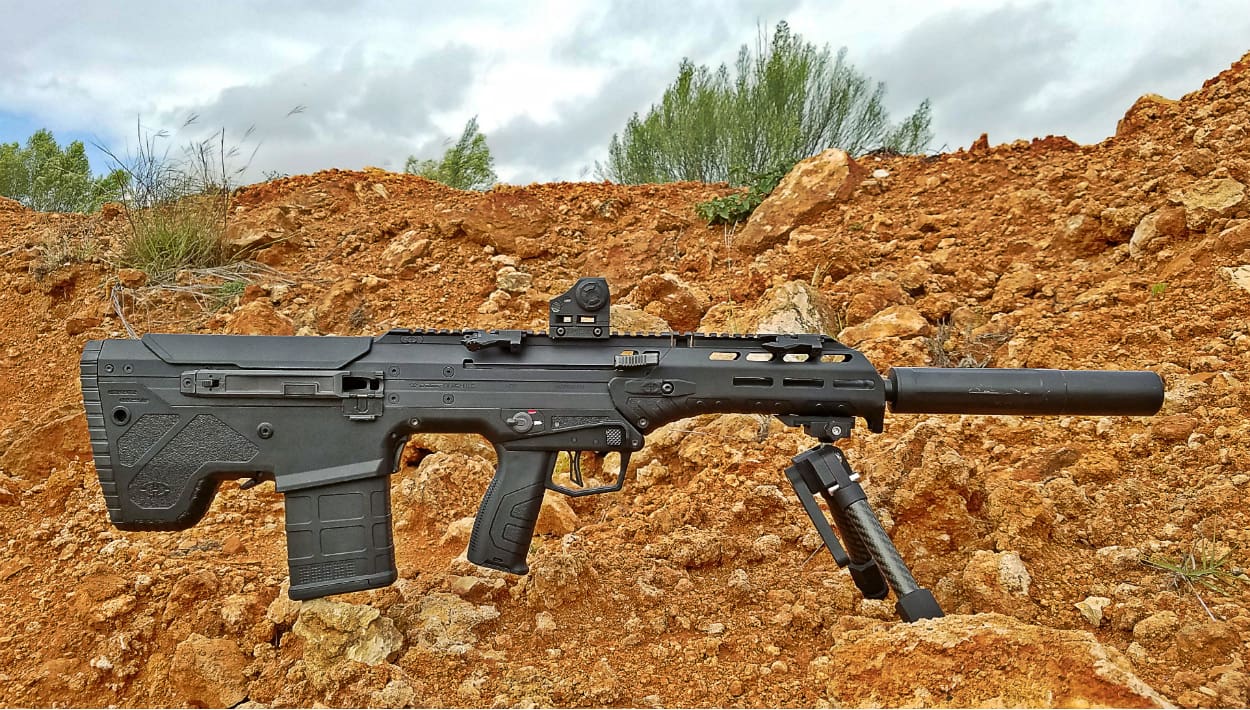
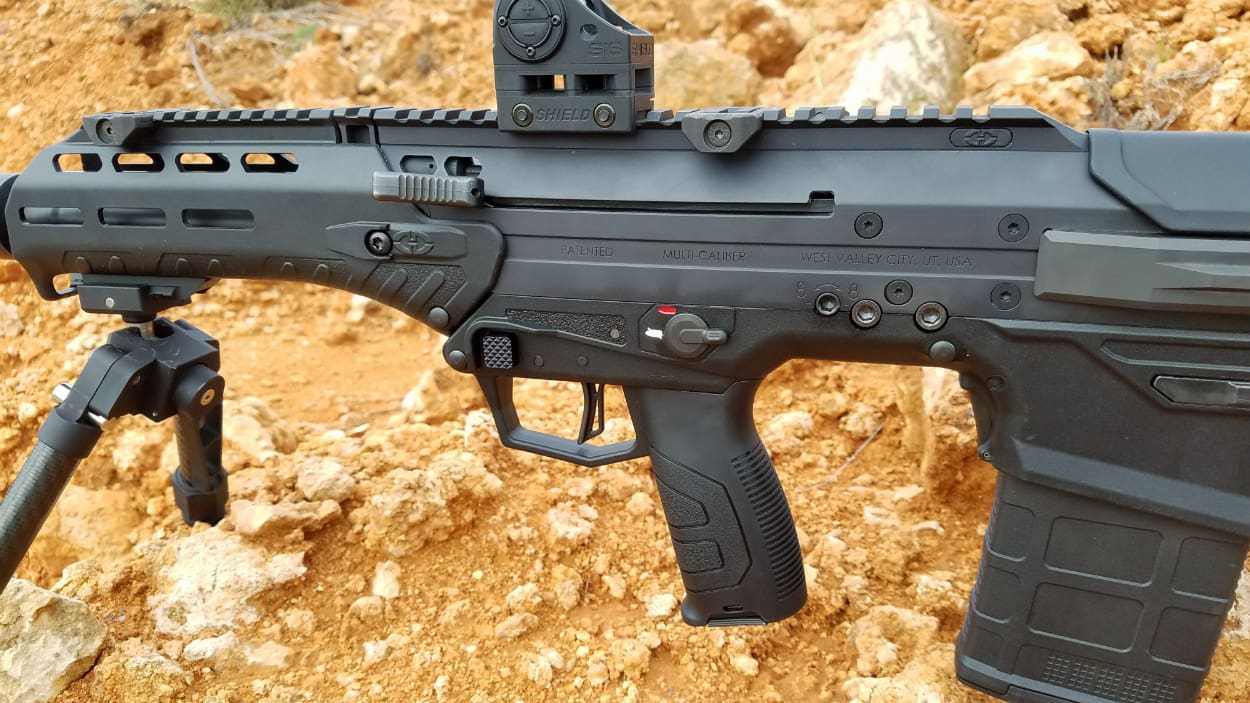
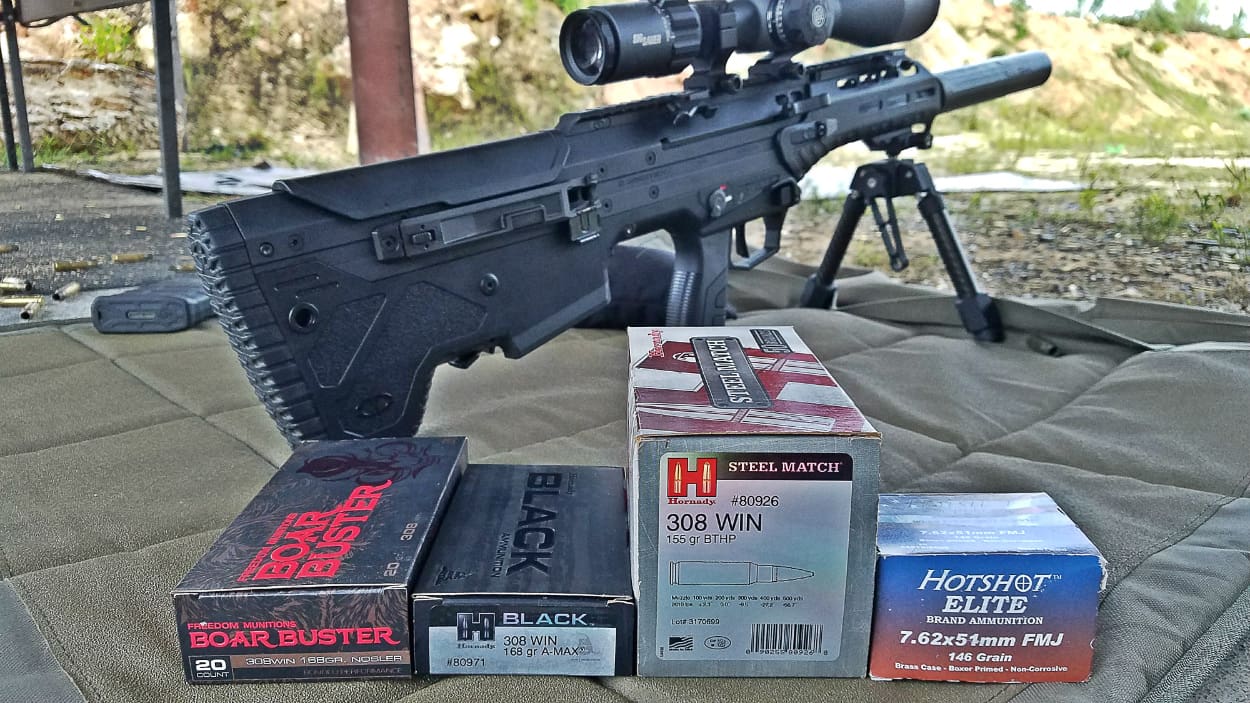
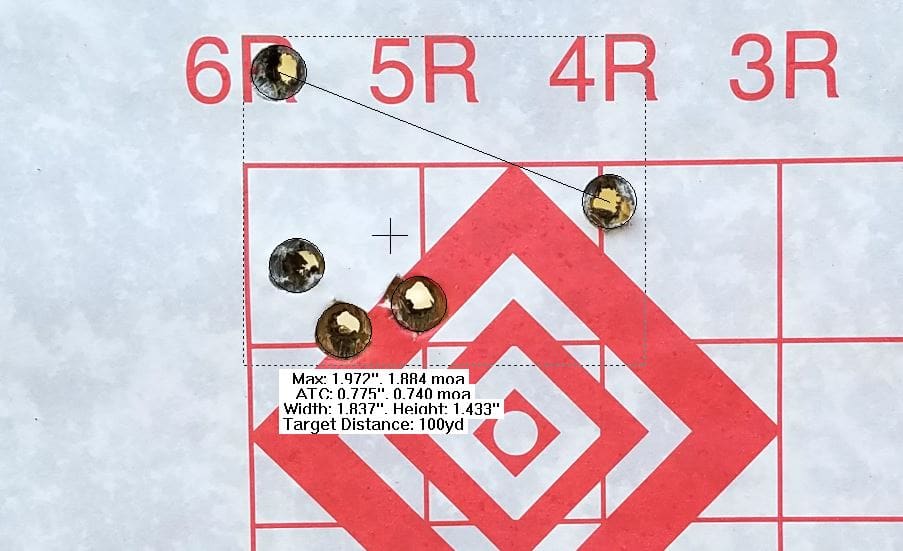

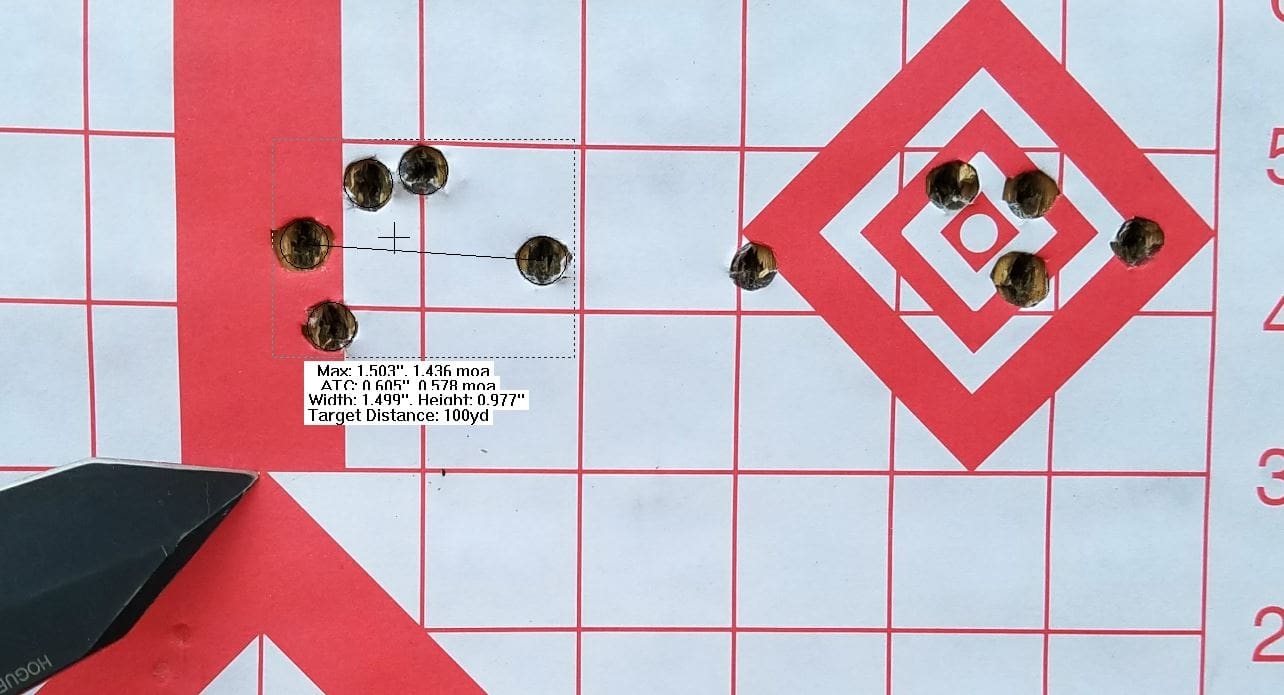
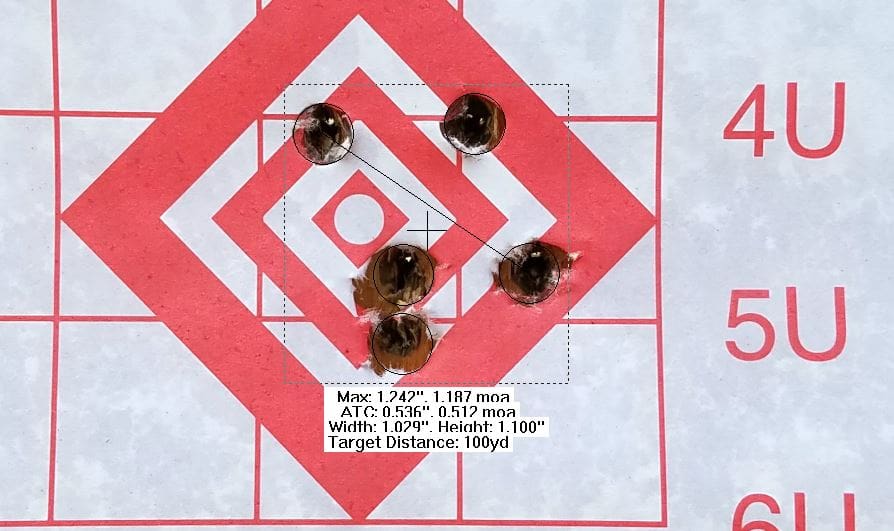

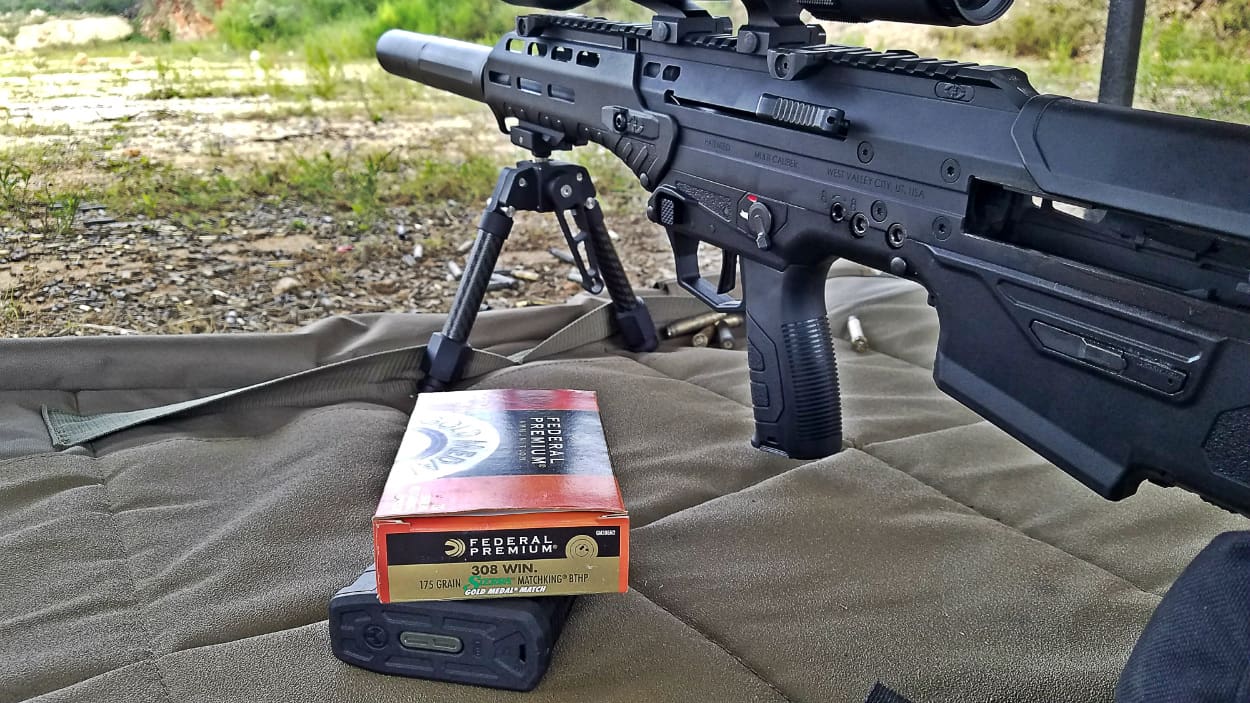

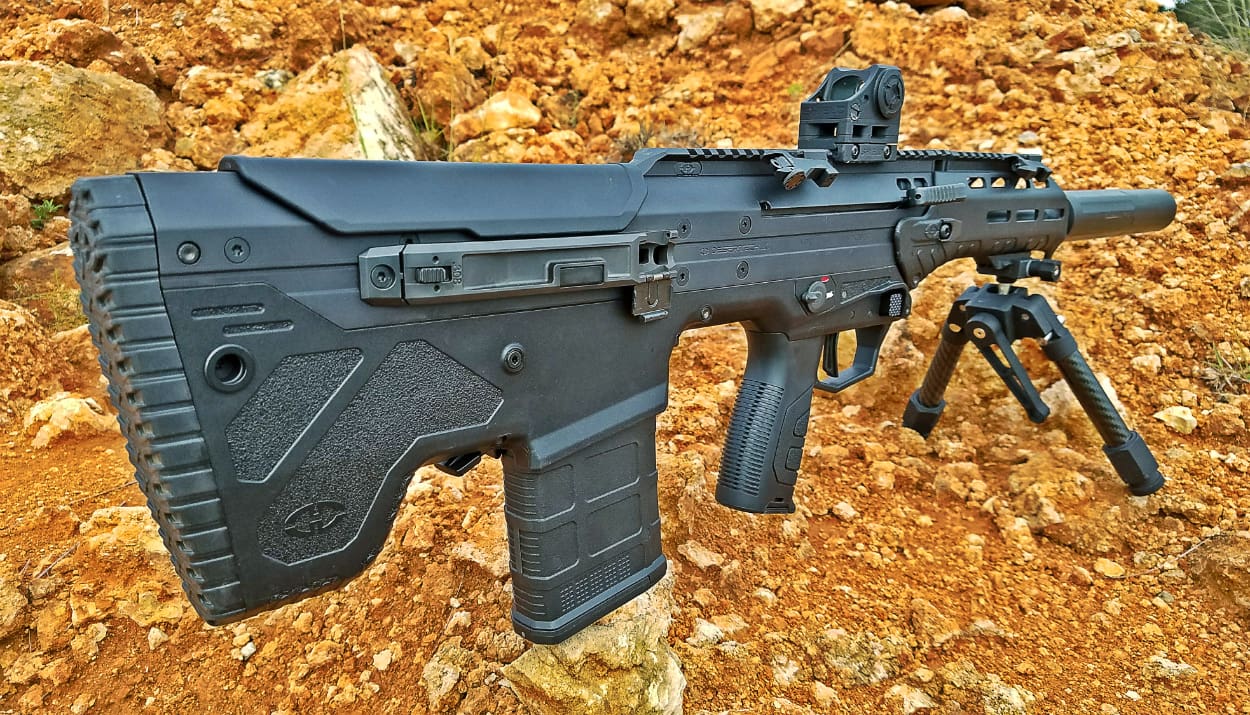
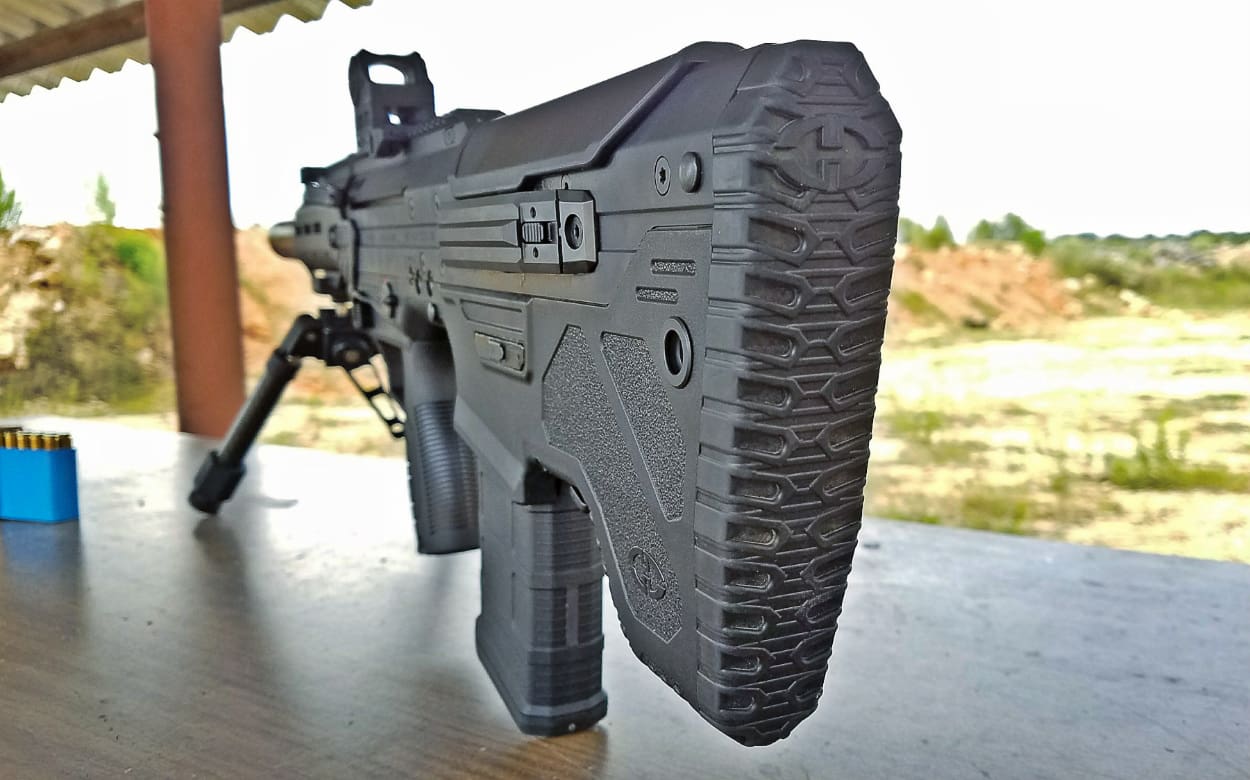

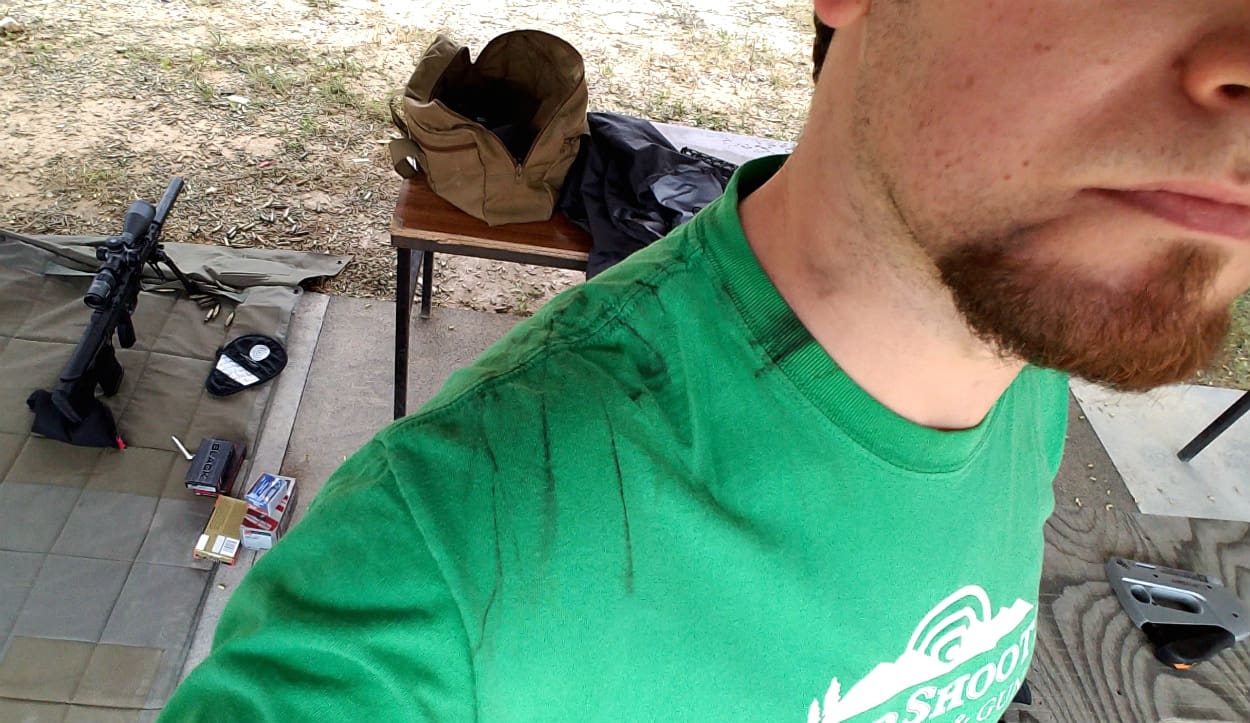






Nice review. No one has yet published hard db readings from the MDR. I’d be very interested in a db@shooter’s ear comparison between the MDR and other semi 308s: DPMG GII, HK MR762, a full size SR25 pattern 308. Using whatever can is convenient and optimized gas settings across the board. I want to like the MDR but worry that it would not make a great suppressor host.
Thanks. I am glad you beat Nick to it. He has been spending too much time earning a living and too little entertaining me lately.
Off Subject. What bipod is that and can you load it with that pivot design?
Rugged Ridge Outdoors Extreme Pod. I need to get around to writing up the review on it as I’ve been using it for a really long time now. It’s fantastic. Yeah, you can load it up just fine —
best if it’s in the fully-vertical position where it’s physically blocked from rotating further,
but it locks down very snugly on its ball mount in any orientation.
http://www.ruggedridgeoutdoorgear.com/extremepod/
Thanks, This was on my bipod list awhile ago, but I forgot about it. Thanks of the info…
OK. So a fairly expensive bullpup that isn’t accurate.
Solid pass.
I’m certainly not a fan of the MDR, but why do you label a 1 moa gun as inaccurate? This isn’t a bolt action rifle you’re talking about.
It’s a 2 MOA gun
It may have been 1-2 MOA with this shooter and the limited section of ammo he used, but other owners and reviewers have reported getting sub-MOA with no problem with the right ingredients.
Plastic. 16 inch 308 , ballistic prob similar to 30-30? Bullpup. Price. .. interesting firearm, I like some features. Thanx but no thanks
The “upper” is steel. The “lower” and handguard are plastic. I’m totally fine with the lower, by the way, but wasn’t the biggest fan of the handguard. I think that would actually be a lot nicer, though certainly more expensive, in aluminum. If MDRs prove popular I’m sure the aftermarket will respond here. Something aluminum that can extend over much of a suppressor would be pretty darn sweet.
I wish you had mentioned the 2 year bait and switch desert tech did on MDR preorders. I almost pre ordered mine in March of 2015 when they said they were 2 months away. I am so glad I bought an X95 instead.
I’m not actually sure if I knew about them taking pre-orders on it. If I was aware of that, I forgot about it years later when actually writing up this review here. At any rate, it may suck but it wouldn’t affect the review of the rifle itself; it is what it is.
Not knowing gunmaking, could it have been designed to vent the combustion gasses down, forward, or a combination of the two?
The idea of a Steyer AUG in a major caliber intrigues me, but the dirt-in-the eyes is a major turn-off…
Theyre making a Tavor in 308 that’s supposed to come out soon, if you’re willing to wait.
That I can do, thanks for the heads-up…
What are the back up iron’s you have on there?
Wrapping up some testing on the Strike Industries Sidewinder sights. They flip between centered over the rail at AR height to being offset at 45* to being folded down on the side. Pretty cool.
2500 is WAAAAYYY to much, even 2000 is too high.
I’ve only shot a bullpup rifle once, but I love the concept. It was like a revelation (never mind the crappy-ass trigger).
This rifle seems like a pretty sweet firearm, all in all…especially the full-powered cartridge in such a compact package. If I had $$, I’d buy one.
Thank you for the review! I’ve been excited about this gun for a while, but the endless delays made me super skeptical. I had read stuff on preproduction rifles with godly triggers, so I’m disappointed that the production trigger is mediocre. This thing was supposed to be the pinnacle of bullpup design and it seems like it’s just another solid offering instead. One thing that I haven’t seen touched on in any reviews and am super curious about: what’s the deal with the safety engineering for overpressure from squibs, etc? Desert tech posted a video comparing the MDR failing (not catastrophically!) with a manually obstructed barrel vs an unnamed competitor (which pretty much blew up). Is there any visible failsafe? Is it just really sturdily constructed?
Hmm, not sure of anything specific related to that sort of failsafe. Though I do know many military contracts require operator safety in the event a round is discharged into a plugged barrel. What I can say from my time with the rifle is that the steel barrel is (I do believe) a one-piece unit without a separate barrel extension, which makes it inherently stronger, and the chamber and ejection port area is all surrounded by a one-piece steel chassis. Many other guns are aluminum or even polymer around these areas, so the steel construction would add some safety factor in the event of a kaboom that blows out the back of the case. Though I wouldn’t want to bet that the ejection ports remain in place if that happened and, based on their position, one of them could certainly smack you in the teeth. Hopefully if that sort of kaboom into the ejection port area event happened, all the pressure would simply blow down and out through the magazine or blow the whole magazine out and spare the ejection ports and whatnot (which I’d say is fairly likely).
The barrel is not one piece. There is a barrel extension screwed on just like an AR or the SRS. The gasblock is of course a separate piece as well. I don’t see this as a fault but more of a feature. For those who would rather have some more useable calibers it makes it simpler to make barrels in some of the 6.5mm cals for the 308 setup as well as the other choices that can be had in the little AR types.
Great review!
I’m not sure how much I’d blame the gun for the “gas in the face” issues. I think the responsibility is on the suppressor design, not the rifle design. It’s time to put more pressure on suppressor manufacturers to address the increase in backpressure. Multiple designs are on the market now that do much better–let’s encourage the trend.
The gun takes the blame here not because it exhibits blowback when suppressed, but because it exhibits far more blowback than average despite being apparently suppressor-ready with an adjustable gas block that specifically has a “suppressed” setting on it.
Unfortunately most of those low-backpressure suppressor designs are significantly heavier and not as quiet (although in some cases, and this could be one of them, they’re occasionally quieter at the shooter’s ear, which I agree is more important). The adjustable gas block on this rifle is designed to adjust for suppressed shooting, but did not do so. It was grossly over-gassed and the action perhaps unlocks a bit too quickly (a longer delay allows more gas and pressure to exit the muzzle, rather than come back into the action). I’ve run this exact same suppressor on multiple semi-auto .308s that exhibited far less blowback than the MDR here. Desert Tech’s own suppressors use a traditional style baffle design, too, and one would have to assume they tuned the gas block predominately with their .30 cal can as the tester. YES, suppressors can be made to minimize backpressure but my Dead Air Sandman is a standard design with approximately standard backpressure and that’s the standard thing to tune a suppressor-ready gun for.
Even if it remained overgassed but everything was sealed up better and the gas only shot out the forwards ejection port it would be 1,000x better.
So if you’re a gun manufacturer, which is the better option:
1. tune the gas so the gun is reliable with a wide range of ammo and deal with people complaining about gas in the face when they use a suppressor that generates more backpressure than another option, or
2. tune the gas so that the gun shoots as soft as possible and doesn’t put gas in the shooter’s face, and then have reviewers and user reports on the Internet complain about function issues, including when using a suppressor that generates LESS backpressure than others (usually considered a DESIRABLE feature)
They are in a no-win situation. Sure, you can talk about sealing openings but that’s a completely separate conversation with different considerations. If we are focused on the gas, they could give the adjustment 20 settings like others have done, or pick a middle ground and try to keep it simple with only 3 settings. How do they know what suppressor you’re going to use?
I think they took the right approach–tune the gun to run reliably unsuppressed with with the typical range of ammo types, and then let the user sort out the gas issue with their selection of the suppressor. OSS isn’t the only game in town now–I could cite at least 5 manufacturers who either already offer products with zero-backpressure claims or are promising it coming soon.
Sure, I get what you’re saying. And I agree that reliability comes first. But we’ll have to disagree on the entire rest of it.
1) The reason the blowback is a noteworthy problem with this gun is because it’s worse than with nearly any other gun. You can argue for tuning it to run any type of ammo reliably, but the fact remains that many other guns accomplish this with far less blowback, even when they don’t have an adjustable gas block (let alone one with a setting called “suppressed”) and are run with this same suppressor. Therefore, there is something inherent in this gun that is causing more blowback than with other guns and is properly assigned directly to the gun, not to the suppressor. What if I told you this gun reliably runs light-loaded (e.g. Hornady 125 grain Custom Lite) ammo on the “suppressed” gas setting without a suppressor? Is it a stretch to conclude that this MDR is, in fact, overgassed?
2) If a suppressor adds no backpressure then you would run the gas block on “normal.” It makes no sense to tune a “suppressed” setting around a no-backpressure suppressor that behaves in this regard like the factory flash hider. There’s no technical or business case for tuning a gun around a suppressor design that represents the tiniest fraction of the industry and is sold on the basis of not needing to be tuned for. The sole purpose of a suppressor setting is to adjust for the fact that 99% of suppressors add backpressure. If your suppressor choice has such little backpressure that the gun doesn’t run reliably on “suppressed” then you simply run it on “normal” and call it a day. There’s also the backup of the high-gas “adverse” setting. And, again, Desert Tech’s own suppressors are of a standard design so the suggestion that the gun was made to force users to choose a niche low-backpressure suppressor from another company seems highly unlikely.
3) You’re right that new suppressor designs can reduce backpressure, but gun designs can reduce the effect of backpressure without sacrificing reliability, too. Controlling where and how the gas exits is one way, and it certainly isn’t a different conversation. A longer action delay is another way. A bore evacuation system is another way. A more tunable gas system is another way.
As for suppressor designs…much of my professional background is in automotive parts design. Backpressure is a big consideration in car mufflers (which were invented by Hiram Percy Maxim, by the way, the same guy who invented the firearm silencer). There are many straight-flow and otherwise flow-through designs that generate no additional backpressure and there are other designs that have some degree of baffling, which are reduced backpressure, and there are standard baffled designs with higher backpressure. With the same size muffler, noise reduction is unfortunately associated directly with backpressure and there has never been a flow-through design that can be as quiet, despite over 100 years of effort in a market that’s effectively unregulated compared to firearm silencers. It’s nearly a linear trade-off. If you want flow-through and quiet you have to go larger. Ultimately, they work on nearly the same principal: trapping and cooling the gases before allowing them to exit. The less you trap, which is what causes the backpressure, the less effective it is at reducing sound level. Or trap but make the thing huge, and you’ll get low backpressure and low sound at the expense of size and weight.
* wave cancellation is also possible, but works only on a specific setup (e.g. a tuned exhaust system on an engine that runs only at a specific RPM or on a firearm tuned for a very specific barrel length and ammo load).
You have a lot more trigger time than I do, including with other .308s, so I’ll happily defer to you on the question of how this one compares to others. And yes, it’s certainly possible that this gun is over-gassed, but before concluding that I’d like to see you have a conversation with them about it and see what drove their design decisions.
My main concern is that I think the gun community needs to shift the conversation about gas-in-the-face away from weapons design and toward suppressor design. I don’t think the only option is “flow through”. Simply adding more interior volume should help with the problem as well. We see Q going that direction, as well as others. Nick Young (Desert Tech CEO) said on FaceBook that his favorite suppressor on the MDR was the Amtac, which adds a lot of interior volume in the over-the-barrel section. I’d like to see somebody put the Amtac products on a meter, but right now they look like they could be the perfect solution–only adds 3.7″ past the barrel, and fits nicely under the bigger handguard that they offer.
“I’d like to see somebody put the Amtac products on a meter…”
Their own specification is 17-22 dB reduction on 7.62 (not enough to make a .308 hearing safe). My Sandman Ti is ~30-31 dB and the Q Full Nelson is more like 31.5 dB (Q Half Nelson about 25 dB despite being shorter than the Amtac by an inch). IMHO the Amtac has less backpressure due to having significantly fewer baffles (it traps less gas), not more internal volume. It has less internal volume than the other three suppressors mentioned here. When I shot both of the Q Nelsons back-to-back against my Sandman Ti I didn’t notice a difference in blowback.
In this Desert Tech promo video (https://www.youtube.com/watch?v=MDn_Gp2QWss), there are photos of “Operator” types with a Dead Air Sandman L and also a Sandman S on MDRs and then there’s live shooting footage of the MDR with the Amtac on it. You can see plumes of gas jetting out around the recoil pad and action area.
“I’d like to see you have a conversation with them about it…”
They’re addressing this with a better gas selection.
So another option (taking by the Keltec RFB) is to use a variable gas port you can dial in. Granted there are weaknesses in their design and I had to do my own modifications to the gas system as there wasn’t enough adjustment range, but now I can tweak the system into the exact level I want.
Huh. Guess the 308 MDR finally stopped being vaporware after 4+ years of promises. LOL!
Still, this is too rich for my blood. I love bullpups (own 3) but I’ll wait for the price to drop (if it ever does). Then I might consider getting one.
Meh. If I’m going to go the trouble of a rifle in a full-power cartridge, it won’t be a battle rifle. Either go belt-fed or precision; .308 has no place in an all-around infantry rifle. I’ve sort of grown to hate the chambering; precisely no .308 I’ve shot has been anything like pleasant.
Whoa, whoa whoa now, try not to freak anybody out. Just because massive amounts of testing (and like, math) in the 1950s told the US Army that small/fast calibers would be more effective, and every military in the world got rid of “full power” rifle cartridges in main-infantry rifles decades ago, that’s no reason for you to go and mess with everybody’s machismo about big bullets!
They should seriously come out with a 6.5 / .260 barrel. Even in 18 inches. I’d have a LOT of use for that.
They have promised 6.5 Creedmore and longer barrels are coming eventually (as well as SBR versions), but there is no advertised timeline yet–they are just trying to catch up on pre-orders for the next few months.
I’ve been on the preorder list since Feb 2016, basically just after they opened preordes at the NRA show. That’s a paid in full preorder direct through DT. I still have not received mine and my current ship date is at the end of November which was recently updated from the end of October. I’m not betting on getting mine before Christmas. If you ordered the 556 version, I think they are in for a longer wait. I bet we don’t see in different accessories or barrels well into 2018 or maybe even 2019. I hope I’m wrong, but this rifle has done everything painfully slow.
I know this is an old post, but I have a 6.5 creedmoor barrel for my mdr. First one in existence I do believe. It was a custom 18 inch. It’s an amazing gun in 6.5
It is clear the writer is NOT a left-handed shooter. If so he would not denigrate the reversible ejection port system.
Right, I’m not. But I fired it left-handed without switching the port over and it’s completely fine that way thanks to the forwards ejection. It’s even nicer than shooting an AR on the wrong shoulder and worlds better than doing that with a Tavor. I think the ambi charging handle, bolt release, safety, and mag releases are a bigger deal for lefties on this gun than the ability to switch the ejection side. Though that’s certainly icing on the cake.
He didn’t denigrate it. And he acknowledged that lefties might appreciate it alot more.
Jeremy, have you done a review of the Shield SIS red dot sight? If not, can you do one? I’m very interested in it.
A video review would be greatly appreciated as well. I’ve searched the net, and there’s nothing really of quality out there.
Late to the party here.
Would love to see a faceoff with this, rhe K&M and thr Tavor 308
Just filled out the paperwork for my MDR here in the People’s Socialist Republik of California. I got on a wait list like 6 months ago, they (the gun shop) called me a few days ago I got the 308 version in FDE. It will come with the Kydex pistol grip covers, and since the rifle measures only 26″ I have to put on a barrel extension to make it the legal 30″ in CA. Looking around on the internet, I am in the market for a barrel for this chassis in 6.5 CM. I’m also wanting to get the 556 barrel assembly but I’m finding out that the 556, it’s a major back order. I can wait, but it’s gonna be so cool to be able to swap out calibers using the same chassis, I’m a big fan of everything “modular” Right now I’m really looking for a 308 barrel extension that has a muzzle brake machined into it. So anyway, if I can get one, I would assume that they are available in the market. If I can get one, they must have filled a whole lot of the pre-orders. Because I didn’t pre-order one. 8 days to go, in a 10 day wait. California
6.5 barrels are available–ask around in this FB group or scan old posts for details:
https://www.facebook.com/groups/1157752664331641/
A few comments after running one for a bit.
Pretty disappointed in the barrel. Its very thin and slow mo shows it flopping around quite a bit. I’m sure that has something to do with the accuracy or lack thereof. The bore seems a bit rough as well and not in any way similar to the quality bolt actions they build.
You have to remove the handguard to do anything. Change the barrel, pull the handguard first. You want to adjust the gas, pull the handguard. Can you do it with a simple pin pull? No you can’t. You need the torx bit on the special tool that is a pain to carry. Why isn’t there a slot where the adjuster is so you can use a pin or screw driver to adjust? No answer there.
The rifle seems to be pretty picky about ammo. Some won’t cycle and others stick in the chamber while the rim has a chunk torn out.
With the ejection port covers installed there is no way to see what’s going on inside. Jams are painful to clear and with some ammo are frequent. You can pull off one of the covers and the rifle will eject 20-30 feet straight to the side but that kind of defeats the purpose.
As noted the mag release is draggy even after a few hundred rounds and changes.
The trigger is pretty bad. Kahrs 308 bullpup has a better trigger which is sad. Its over $1000 cheaper too.
The good-
changing cals is nice. While DT isn’t offering anything right now others are making some neat stuff. Someone in Utah is doing 6.5 Creedmore. Some guy in the midwest has done 6.5 X 47 and some wierd 338 subsonic round. I also saw one rifle in 260 rem. Talking with DT the gasblocks and barrel extensions aren’t available so no idea where they’re getting parts.
Overall its a neat rifle and has some things going for it but the cost is up there. I can’t see it really being any better than the new 308 Tavor and even the Kahr offering is a better buy for the money. I won’t dump mine but I won’t buy another.
Timmie
I was entertaining buying a Desert Tech MDR in 223 Wilde and converting it to .308 or 6.5 Creedmore as needed in the future. Your excellent review said ‘wait’ until some of the kinks are ironed out of this interesting and competent rifle.
I have an M6A2 14.7 inch barrel in 5.56 that is about 1 MOA with match ammo. Trigger = Geissele SSA-E and it makes a HUGE difference.
I recently purchased a M6A2-PSD upper, never mounted, never fired, for it on Gunbroker.com for a most EXCELLENT price. 8.5″ barrel makes it an SBR at 25″overall. Fits my lower really well.
Will purchase a tax stamp and a Sandman K or S (and another tax stamp) and see how it goes.
No gas problems at all with the suppressed M6’s that I have fired.
Thanks again for the excellent and competent review.
Check out the Dead Air Nomad, too. Great suppressor! I recently shot the MDR in 5.56 (there’s a hands-on article on here) and liked it even more in the smaller caliber. They’ve also improved the trigger fairly noticeably.
Thanks for the update. I’ll check out the Dead Air Nomad.
DTA makes awesome bolt action bullpups pretty much match or hunt ready…but this MDR…for the price it should have a great trigger not a so-so slightly better than a milspec trigger. Interested to see how the project further develops
Best review I have seen on testing for accuracy. Any comments on reloading the spent brass? TAVOR puts big dents in the brass. Some of the other reviews on the MDR talk about extraction problems where the rim of the case are damaged because of the bolt head design.
I would go with another company. I have waited 5 months for a conversion kit, after waiting 2 years for the MDR. Then I had to send it in for them to fix the whole thing. They have your money in advance, so no sweat for them. They have promised me every week a next week ship date for my kit. Frustrated.
Gear up as your favorite Delsin Rowe Vest. Slim Fit Leather Jackets brings this iconic jacket from animation to reality, especially for all the fans of this video game. Delsin Rowe is the main protagonist and playable character, a young Native-American man who later realizes he’s a Conduit with special powers.
I don’t see the point of 300 BLK on this when its bullpup design allows sufficient barrel length for 7.62 NATO, and 308 & 7.62 NATO both afford the advantage of not only equivalent subsonic rounds but better supersonic rounds than 300 BLK. The whole point of 300 BLK is to have both subsonic and supersonic available in a conventional non-bullpup design with a very short barrel that would be unable to make good use of 7.62 NATO. If you don’t want a bullpup, need both subs and supers, and require a short rifle, then 300 BLK will get you there just at a premium price. The DT MDR in 300 BLK would be an expensive way to use inferior rounds.
Comments are closed.